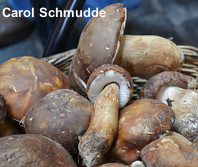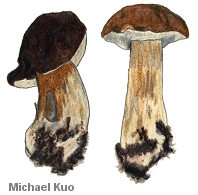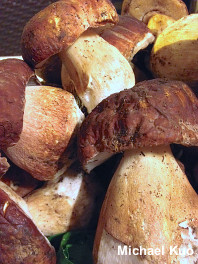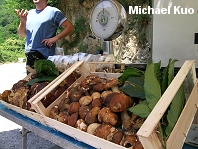Boletus edulis
[ Basidiomycetes > Boletales > Boletaceae > Boletus . . . ]
by Michael Kuo
Known as the cep in France and the Steinpilz in Germany, Boletus edulis is a well-known European bolete that associates with spruces and, depending on how the species is defined, various hardwoods. It is a large mushroom with a greasy to tacky, bald, brown cap and a meaty, swollen stem that features fine reticulation. The pore surface is initially white, with "stuffed" pores--but as the mushroom matures the pores become more visible and the pore surface becomes greenish yellow. The flesh does not change color when the mushroom is sliced, and its surfaces do not bruise on handling.
Whether or not the "true" Boletus edulis occurs in North America is up for debate. Mushrooms meeting the general description above can be found in diverse North American ecosystems (see the key below for 14 North American edulis-like species). However, recent research has revealed potential differences in ostensibly identical "Boletus edulis" collections in North America and Europe. Studies by Arora (2008), Dentinger and collaborators (2010), Nuhn and collaborators (2013), Arora & Frank (2014), and Wu and collaborators (2014) have begun to sort out the edulis-like species, but much more work needs to be done. If you have a well-documented edulis-like collection you would like to contribute to further study of this species group, please see this page.
Boletus edulis is the "type species" for the genus Boletus, which means it is the species that is supposed to represent the genus. This fact means that Boletus edulis and its close relatives will by taxonomic necessity belong to Boletus even as mycologists split the formerly large genus into a mind-numbing number of new genera.
REFERENCES: Bulliard, 1780. (Fries, 1821; Saccardo, 1888; Moser, 1983; Breitenbach & Kränzlin, 1991; Hansen & Knudsen, 1992; Knudsen & Taylor, 2008.)
This site contains no information about the edibility or toxicity of mushrooms.




